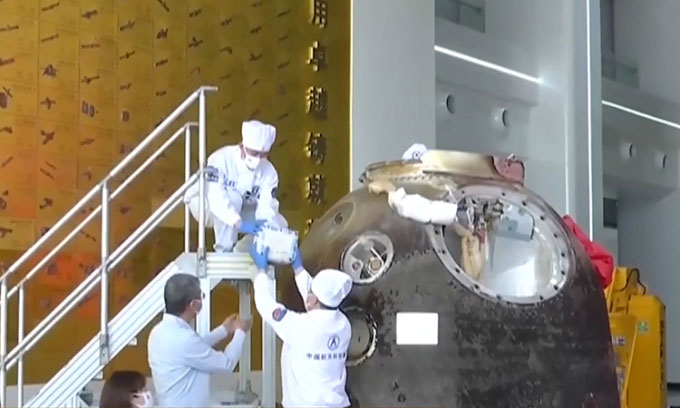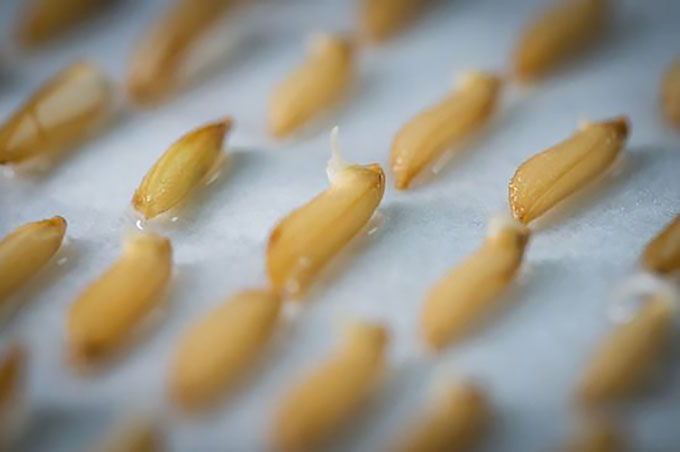China promotes genetically modified crops in space
When China's Shenzhou 14 spacecraft returns to Earth later this year, it will bring back some unusual packages: brewer's yeast grown in space. This is part of a 6-month breeding experiment on the Thien Cung space station under construction.

Shenzhou 13 returned items from space, including 12,000 seeds, back to Earth on April 16.
In addition to yeast samples, the "passengers" of this long spaceflight also had rice, soybeans, vegetables and a variety of bacteria needed in food preservation. They were selected by the Beijing Capital Food and Agribusiness Group.
The company's goal when putting plants and microorganisms into orbit is to stimulate gene mutations under cosmic radiation and microgravity to create superior strains, then propagate and use. below ground to provide high-quality food and beverages.
When samples in space are returned to Earth, scientists will test and evaluate their mutations. Compared with natural hybrids, some have positive characteristics favored by farmers, such as higher yields, shorter growing times and better disease resistance.
One important thing is that space food is safe for humans. Unlike most conventional GM foods that are genetically modified from other species, seeds in space only undergo mutations in their own genes, said Zhao Hui, an expert at the China Academy of Space Technology. they.
Another advantage is that this mutation can produce "unexpectedly positive properties". For example, when Liang Sili from the Chinese Academy of Sciences examined a 500-gram green chili that had been propagated in space, he found that "it contains more vitamins than the common ones and is very tasty!".

Rice seeds sprouted on February 26, 2021 after a trip around the moon aboard the Chang'e-5 probe at a greenhouse in Guangzhou, southern China.
China is one of the pioneering countries in research and application of space cultivation technology to agricultural farming on the ground. The world's most populous nation conducted its first space-breeding experiment in 1987, launching seed packets onto satellites and returning them to Earth after being exposed to cosmic radiation. Since then, seeds of hundreds of plant species have been sent into orbit along with the country's Shenzhou satellites and spacecraft.
Over the past three decades, China's space breeding program has produced more than 300 cultivars and 700 new types of plants, from vegetables, fruits to flowers. The total planted area has exceeded 2.8 million hectares, almost equal to the area of Massachusetts, USA.
Zhao, also general secretary of China's Space Breeding Industry Innovation Alliance, said the space breeding program had helped increase grain production by 1.6 billion kilograms and generated economic benefits. worth more than 240 billion yuan (about 35.6 billion USD).
In central Henan province, Liu Shunde is a farmer who has benefited from space technology. In 2016, he sent 13-gram leek seeds into orbit for 12 days on a recoverable science satellite. After four years of research on the ground, mutations in space leeks have created a new plant that is more resistant to cold and disease. Liu's business has since grown rapidly, with larger plantings, higher yields, and more income.
Similar success stories are also being reported across the country, as space breeding represents an innovative approach to help Chinese farmers improve their yields.
Tests were carried out during all flight missions during the essential technology verification phase of the Thien Cung space station project. Thousands of plant and microbial seeds were sent into space by the Shenzhou 12 and 13 crews and brought back to Earth.
Zhao believes that with the advancement of the space industry, humans will bring more seeds to space and create a "space oasis" in the future, which can offer new solutions for development. global agriculture, protecting biodiversity as well as combating climate change.
- Genetically modified plants still cause doubts
- 'No one can predict the harmful effects of GM crops'
- China: Certification of safety for GM crops
- Manipulating food security?
- Things you should know about GMO genetically modified foods
- Genetically modified insects threaten genetically modified plants
- He called on the EU to approve genetically modified corn by voting
- Countering genetically modified corn causes cancer in mice
- In 2011 began planting genetically modified plants
- Genetically modified carrots resist flu
- India: Genetically modified cotton yields are exaggerated
- Genetically modified corn is ineffective
 Why do potatoes have eyes?
Why do potatoes have eyes? 'Tragedy' the world's largest carnivorous life: Death becomes ... public toilet
'Tragedy' the world's largest carnivorous life: Death becomes ... public toilet Tomatoes were once considered 'poisonous' for 200 years
Tomatoes were once considered 'poisonous' for 200 years Detecting microscopic parasites on human face
Detecting microscopic parasites on human face